ShodhKosh: Journal of Visual and Performing ArtsISSN (Online): 2582-7472
|
|
The Impact of Hindi Cinema on Altering the Adults’ Perception Towards Societal Stereotypes: A Study of Delhi NCR
Karan Singh 1![]()
![]() ,
Dr. Mohammad Aamir Pasha 2
,
Dr. Mohammad Aamir Pasha 2![]()
![]() , Dr. Shivendu Kumar Rai 3
, Dr. Shivendu Kumar Rai 3![]()
![]()
1 Research
Scholar, Jagran School of Journalism and Communication, Jagran Lakecity University, Bhopal, India
2 Assistant
Professor, Jagran School of Journalism and Communication, Jagran Lakecity University, Bhopal, India
3 Assistant Professor, Department of Journalism and Mass Communication,
TIAS, Rohini, Delhi, India
|
|
ABSTRACT |
||
|
Hindi cinema, with its immense popularity and pan-India reach has long been recognized as an influential socio-cultural force in the country. Through propagation of enduring stereotypes in films, it contributes to shaping and reinforcing the attitudes and perceptions of audiences regarding gender roles, communities, professions and societal values. This study aimed to examine the impact of exposure to stereotypical Hindi cinema on altering adults’ perceptions towards commonly accepted societal stereotypes in the Delhi NCR region. A sample of
217 adults aged 18-35 above years was surveyed using questionnaires to assess
cinema viewership patterns, endorsement of societal stereotypes portrayed in
Hindi movies. The findings highlight the powerful influence Hindi cinema
wields in combating regressive stereotypes in society especially among
vulnerable sections like the rural poor with limited education. But rising
education levels are breeding resistance to such stereotyped beliefs. The
paper recommends that Hindi filmmakers should consciously avoid harmful
stereotypes and attempt progressive portrayals of gender, caste, class and
professions. Responsible cinema can play a transformative role in promoting
egalitarian attitudes aligned with India’s development goals. |
|||
|
Received 20 January 2024 Accepted 14 June 2024 Published 21 June 2024 Corresponding Author Karan
Singh, karan11ksingh@gmail.com DOI 10.29121/shodhkosh.v5.i1.2024.915 Funding: This research
received no specific grant from any funding agency in the public, commercial,
or not-for-profit sectors. Copyright: © 2024 The
Author(s). This work is licensed under a Creative Commons
Attribution 4.0 International License. With the
license CC-BY, authors retain the copyright, allowing anyone to download,
reuse, re-print, modify, distribute, and/or copy their contribution. The work
must be properly attributed to its author.
|
|||
|
Keywords: Hindi Cinema, Impact, Societal Stereotypes, Adul,
Perception |
|||
1. INTRODUCTION
Hindi cinema has been one of the most influential cultural forces in India for nearly a century now. As the dominant film industry in the country accounting for nearly half of annual ticket sales, popular Hindi films enjoy a dedicated following among diverse socioeconomic and demographic groups Rao (2010). Many scholars argue that Bombay cinema as Hindi films are often referred to contribute greatly to constructing a shared imagination and collective conscience for most Indians Ganti (2004). Through the chronicling of cultural traditions, societal issues, everyday realities and aspirations on screen, mainstream Hindi movies both reflect and propagate certain ideologies, values and beliefs.
One of the most potent effects Hindi cinemas has had on society is the perpetuation of enduring stereotypes through decades of storytelling and characterization Bharucha (2014). Scholars have identified repeated portrayals of the self-sacrificing mother, the aggressive male protagonist, the pure village belle, the shrewd businessman and similar stock characters across eras of Hindi cinema. Mazzarella (2003) contends that such stereotypes enable filmmakers to employ generic conventions that resonate easily with audiences based on shared cultural understanding. But critics argue that formulaic stereotypes limit more authentic representations of gender, caste, class and community identities prevalent in society Punathambekar (2013).
Exposure to consistent stereotypical portrayals of varied groups through films is known to cultivate perceptions and attitudes among audiences that align with depicted stereotypes Shrum (2004). Social cognitive theory posits that individuals adopt behaviors and perspectives modeled in media into their own belief structures through observational learning processes Bandura (2001). Previous studies have examined Hindi cinema's effects on perpetuating gender stereotypes Khan et al. (2016), racial biases Gorham (1999) and misrepresentations of certain communities and professions Kaur (2002). But there is limited research on how stereotypical Hindi movies may shape broader societal perceptions regarding gender roles, caste hierarchies, class divisions, and cultural stereotypes among Indian adults of Delhi NCR. This study aims to help in addressing this gap by analyzing the impact of exposure to mainstream Hindi cinema on altering adults' endorsement of societal stereotypes in the Delhi NCR region.
2. Operational definition
This study examines how Hindi films impact viewers'
perceptions and actions related to different types of stereotypes. Societal
stereotypes refer to "beliefs held by most members of a social group
about the characteristics of another group" Crocker
& Lutsky (1986), p. 554, measured by
how frequently movies like "Bala," "Pink," and "Badhaai Ho" challenge or reinforce these widespread
societal beliefs. Gender stereotypes are "beliefs about the
psychological traits and characteristics of, as well as the activities
appropriate to, men or women" Ashmore
& Del Boca (1981), p. 219, assessed by
the impact of films like "Queen," "Dangal," and
"Lipstick Under My Burkha" on traditional
gender role perceptions and viewers' willingness to defy constraining gender
norms. Cultural stereotypes involve "beliefs that associate a
certain group (ethnic, regional, etc.) with certain traits" Hilton & Von Hippel (1996), p. 240), while regional
stereotypes are a subtype involving "overgeneralized beliefs about
people based on the region or area from which they come" Shaver
et al. (2017), p. 91. These are
measured by how movies like "Piku," "PK," and "English
Vinglish" influence viewers' perspectives on
ethnic, cultural and regional stereotypes. Analyzing
viewer data across these different forms of stereotypical beliefs allows
understanding of how the powerful cultural influences
of Hindi cinema relates to perpetuating, reinforcing or defying common
stereotypes.
3. Review of literature
3.1. The Influence of Hindi Cinema
in India
As the dominant cultural form, Hindi cinema wields enormous influence in propagating cultural values, social norms, and ideological messages in India Dwyer (2014). Popular media personae, storylines and songs permeate everyday discourses. Several dimensions of cinematic influence have been studied - Desai (2004) showed associations between film melodrama and audience emotions, while Chopra (2011) revealed aspirations shaped by celebrity lifestyles and consumption patterns. Others highlight the role of films in constructing national and historical narratives Virdi (2003). However, limited research examines Hindi cinema’s effects on societal stereotypes despite recognition of its stereotype-laden imaginings of social realities. This remains an important gap in fully understanding Hindi movies’ cultural influence.
3.2. Empirical Evidence of Hindi
Cinema Influencing Attitudes
Although limited, some studies provide evidence for effects of exposure to stereotypical Hindi films on audience attitudes. Khan et al. (2016) found greater reinforcement of patriarchal gender norms among regular Hindi movie watchers. Sharma (2018) showed correlations between frequency of watching Hindi films and holding stereotypical caste associations. Karan (2008) revealed certain professions were perceived along stereotypical traits commonly depicted in Hindi cinema. Further, Desai & Basuroy (2005) evidenced casual sexism and materialism in urban youth highly exposed to commercial Hindi movies. However, more direct causational studies are required in this area.
3.3. The Influence of Media
Stereotypes
Some studies have examined the role of media, including films and television, in perpetuating stereotypes related to gender, race, ethnicity, profession and other social categories. Cultivation theory posits that consistent media images cultivate perceptions of reality among audiences that align with these stereotypical portrayals Shrum (2004). Gerbner et al. (2002) found television exposure cultivated exaggerated perceptions of violence, gender roles, and occupational statuses. Media representations also propagate stereotypical assumptions about community identities, especially marginalized groups. For example, Ramasubramanian (2011) showed exposure to Muslim stereotypes in films increased prejudice. Specific to Hindi cinema, scholars argue that formulaic character tropes reinforce regressive gender archetypes Khan et al. (2016), as well as represent lower castes and classes in reductive ways Gokulsing (2004). Thus, prevalent media stereotypes shape broader social attitudes and beliefs.
3.4. Adult Media Influences
While children are seen as more susceptible to media effects, adults demonstrate effects of observational learning and cognitive priming based on media exposures Igartua & Barrios (2012). For instance, Holbert et al. (2004) evidenced film stereotypes altered social judgments among students. Behm-Morawitz & Ortiz (2013) found endorsement of gender myths in films predicted sexist attitudes in adults. Ramasubramanian (2015) showed higher identification with Indian culture increased effects of stereotypical media exemplars on adults’ prejudiced beliefs. Thus, Hindi film stereotypes likely shape adult perceptions of gender roles, communities, and social values due to cultural relevance. More focused research is needed in this area.
3.5. Stereotype Endorsement and
Media Effects Theories
Social cognitive theory explains media effects through processes of observational learning and identification whereby viewers model behaviors and attitudes portrayed by characters Bandura (2001). Schema theory also shows media provides frameworks for understanding social groups that audiences internalize Baran & Davis (2009). These effects are further explained by cultivation theory which argues repeated media imagery shapes audience perceptions of reality over time Shrum & Lee (2012). Together, these theories elucidate why endorsement of stereotypical views prevalent in Hindi movies is likely among regular adult viewers.
3.6. Research Gaps and Future
Directions
In summary, the review of literature establishes that while media stereotypes shape attitudes, focused research on effects of pervasive stereotypes in Hindi movies is lacking, especially in adults. Further empirical examination of these effects through surveys, experiments and in-depth interviews can provide greater insight into Hindi cinema's influence on societal perceptions and endorsement of stereotypes related to gender, caste, class, community, profession and culture among regular adult viewers. This can inform strategies for more responsible filmmaking practices.
4. Research Objectives
·
To
examine the Frequency and Genre Preferences of Hindi Film Viewership.
·
To
assess the Impact of Specific Hindi Films on Perceptions of Societal
Stereotypes.
·
To
evaluate the Role of Hindi Films in Motivating Actions against Stereotypes.
5. Research Methodology
Type of Study: This
research study utilizes a quantitative approach to assess the impact of Hindi
films in altering the perception of adults in Delhi NCR. The objective is to
collect numerical data through a Survey and analyze
it statistically to gain insights into the impact of Hindi cinema in altering
perception towards societal stereotypes in special reference to the adults of
Delhi NCR.
Sampling: A simple random sampling technique has been employed to select participants for the study. The target population consisted of adults aged 18-35 in various institutes, industries and sectors within the Delhi NCR region. From this population, a sample of 217 adults between the age group of 18-35 voluntarily participated and responded to the questionnaire. The sample size of 217 was determined based on considerations of feasibility and representativeness, aiming to capture a diverse range of experiences and perspectives of adults regarding the Hindi cinema in the region.
Data Collection: Data
has been collected through an online questionnaire using the Google Forms
platform. The questionnaire was designed to gather information about the
interests, perspectives, impacts and experiences of the adults regarding the
Hindi cinema in combating or promoting the societal stereotypes. The
questionnaire included multiple-choice questions and Likert scale items,
allowing for standardized responses. It was shared through various online
platforms, professional networks, and social media channels to reach a diverse
group of participants.
Data Analysis: The collected data are subjected to quantitative analysis using appropriate numerical calculation methods. Descriptive statistics, such as frequencies and percentages, have been employed to summarize the data and provide an overview of the responses.
6. Findings and Data Analysis
1) Age of
Respondents
Table 1
|
Table 1 Age of Respondents |
|
|
Age |
Respondent |
|
18-22 |
103 |
|
23-28 |
44 |
|
29-33 |
17 |
|
34 & Above |
53 |
|
Total |
217 |
Graph 1

|
Graph 1 Age of Respondents |
The responses were taken in between the age group of 18-34 years & above. In which 47.5% of people belonged to the age of 18-22 years, 24.4% of people belonged to the age of 34 year & above, 20.3% of people belonged to the age of 23-28 and lastly 7.8.% of people belonged to the age of 29-33 years.
2) How frequently do
you watch Hindi films?
Table 2
|
Table 2 How Frequently do you Watch Hindi Films? |
|
|
Frequency
of watching Hindi films |
Respondent |
|
Rarely
or never |
13 |
|
Occasionally |
56 |
|
Sometimes |
75 |
|
Often |
39 |
|
Very
Often |
34 |
|
Total |
217 |
Graph 2

|
Graph 2 Frequency of Watching Hindi Films |
Out of 217 respondents, 75 people chose that they watch movies Sometimes, while 56 people chose that they watch movies occasionally, which is 25 percent of the total percentage. The lowest percentage of watching movies is 6%.
3) What genres of
Hindi films do you prefer?
Graph 3

|
Graph 3 What Genres of Hindi Films do You Prefer? |
Out of 217 people, a maximum of 165 people liked watching comedy -based films, while 41 people chose the others option.
4) How often do
movies challenge or break societal stereotypes according to your perception?
Table 3
|
Table 3 How Often do Movies Challenge or Break Societal Stereotypes According to your Perception? |
|
|
Movies
challenge or break societal stereotypes |
Respondent |
|
Rarely
or never |
15 |
|
Occasionally |
52 |
|
Sometimes |
111 |
|
Often |
28 |
|
Very
Often |
11 |
|
Total |
217 |
Graph 4

|
Graph 4 Movies Challenge or Break Societal Stereotypes According to your Perception |
In percent of to the question whether films challenge and break social stereotypes, maximum 51.2 percent people chose that films sometimes work to challenge and break social stereotypes, while 24 percent people chose the option occasionally. Out of 217 respondents, least 11 people chose the very often option.
5) Mark on the
societal stereotypes movies which you have watched.
Graph 5

|
Graph 5 Mark on the Societal Stereotypes Movies Which You Have Watched |
Among the movies mentioned in the above graph, maximum number of 173 people chose Dangal movie and least number of people chose other option.
6) Mention a movie
that you believe effectively challenges societal stereotypes.
Graph 6

|
Graph 6 Mention a Movie that you Believe Effectively Challenges Societal Stereotypes |
In response to the question which film effectively
challenges social stereotypes among the films written in the graph, the maximum
number of 109 people chose the film Dangal which is 50.2 percent of the total,
while Badhai Ho is at the second place which is 41.9
percent of the total, The least number of people chose the others option.
7) To what extent do
movies like "Bala," "Pink," and "Badhaai
Ho" influence your perception of societal norms and stereotypes? (1 is
for the least and 5 is for the maximum)
Table 4
|
Table 4 What Extent do Movies like "Bala," "Pink," and "Badhaai Ho" Influence Your Perception of Societal Norms and Stereotypes? (1 is for the Least and 5 is for the Maximum) |
|
|
Movies
challenge or break societal stereotypes |
Respondent |
|
5 |
17 |
|
4 |
83 |
|
3 |
51 |
|
2 |
41 |
|
1 |
25 |
|
Total |
217 |
Graph 7

|
Graph 7 Movies Challenge or Break Societal Stereotypes |
The data reveals varied perceptions of how Hindi films challenge societal stereotypes. A significant portion (38.2%) rated the influence highly (83 respondents rated 4 and 17 rated 5), suggesting these films often impact viewers' perceptions of stereotypes. A moderate influence was noted by 23.5% (51 respondents rated 3), while 30.4% (41 rated 2 and 25 rated 1) perceived minimal impact. This indicates that Hindi films, particularly those viewed frequently and of specific genres, play a notable role in shaping societal views and can motivate actions against stereotypes for a considerable segment of the audience.
8) How much do
movies like "Queen," "Dangal," and "Lipstick Under My Burkha" impact your perception of traditional gender
roles and stereotypes. (1 is for the least and 5 is for the maximum)
Table 5
|
Table 5 How Much do Movies Like "Queen," "Dangal," and "Lipstick Under My Burkha" Impact your Perception of Traditional Gender Roles and Stereotypes |
|
|
Movies
impact perception of traditional gender roles and stereotypes |
Respondent |
|
5 |
21 |
|
4 |
77 |
|
3 |
60 |
|
2 |
43 |
|
1 |
16 |
|
Total |
217 |
The data suggests a significant impact of specific Hindi
films on challenging traditional gender roles and stereotypes. The majority of respondents (77 out of 217) rated the impact
as 4 on a scale of 1 to 5, indicating that films like "Queen,"
"Dangal," and "Lipstick Under My Burkha"
have effectively influenced perceptions of societal stereotypes. Additionally,
a considerable number of respondents (21 out of 217) rated the impact as 5,
suggesting that these films may have motivated actions against stereotypes.
Graph 8

|
Graph 8 Movies Impact Perception of Traditional Gender Roles and Stereotypes |
9) Have movies like
"Queen," "Dangal," and "Lipstick Under My Burkha" influenced your willingness to challenge
gender-related expectations? (1 is for the least and 5 is for the maximum)
Table 6
|
Table 6 Have Movies Like "Queen," "Dangal," and "Lipstick Under My Burkha" Influenced your Willingness to Challenge Gender-Related Expectations? |
|
|
Movies
influenced your willingness to challenge gender-related expectations |
Respondent |
|
5 |
29 |
|
4 |
67 |
|
3 |
53 |
|
2 |
49 |
|
1 |
19 |
|
Total |
217 |
Graph 9
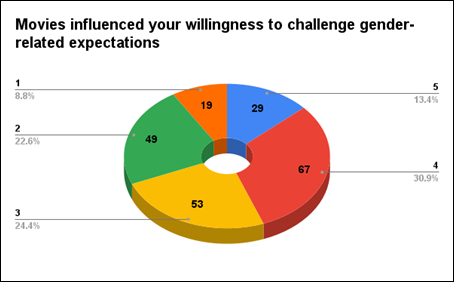
|
Graph 9 Movies Influenced Your Willingness to Challenge Gender-Related Expectations |
The data reveals that Hindi films significantly influence
viewers' willingness to challenge gender-related expectations, with a majority of respondents (67 rating 4 and 29 rating 5)
indicating a high impact. This suggests that frequent viewership of impactful
genres, possibly those addressing societal stereotypes, plays a critical role
in shaping perceptions. Films appear effective in motivating viewers to take
actions against stereotypes, as evidenced by the combined 96 respondents rating
the influence highly. The genre preferences likely include socially relevant
dramas and narratives that directly confront gender biases, illustrating Hindi
cinema's powerful role in societal change.
10) How do movies
like "Piku," "PK," and "English Vinglish"
impacts your perspective on cultural and regional stereotypes? (1 is for the
least and 5 is for the maximum)
Table 7
|
Table 7 How do Movies like "Piku," "PK," and "English Vinglish" Impacts your Perspective on Cultural and Regional Stereotypes? |
|
|
Movies
impact respondents’ perspective on cultural and regional stereotypes |
Respondent |
|
5 |
19 |
|
4 |
75 |
|
3 |
58 |
|
2 |
42 |
|
1 |
23 |
|
Total |
217 |
Graph 10
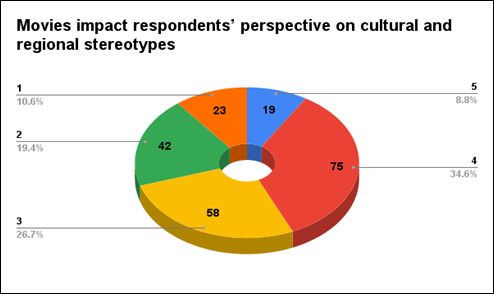
|
Graph 10 Movies Impact Respondents’ Perspective on Cultural and Regional Stereotypes |
The data shows that 43.3% (5 - 19, 4 - 75) of respondents feel that movies greatly impact their perspectives on cultural and regional stereotypes, while 26.7% (3 - 58) are moderately affected, and 30.9% (2 - 42, 1 - 23) experience minimal to no influence. This suggests a significant portion of Hindi film viewers perceive films as influential in shaping and challenging societal stereotypes. The frequency and genre of these films likely play crucial roles, as the strong response highlights their potential to motivate actions against stereotypes, reflecting the power of cinema in societal change.
11) Have movies
played a role in encouraging you to challenge stereotypes in your daily life? (1
is for the least and 5 is for the maximum)
Table 8
|
Table 8 Have Movies Played a Role in Encouraging you to Challenge Stereotypes In Your Daily Life? |
|
|
Movies
played a role in encouraging to challenge stereotypes in daily life |
Respondent |
|
5 |
16 |
|
4 |
63 |
|
3 |
56 |
|
2 |
61 |
|
1 |
21 |
|
Total |
217 |
Graph 11
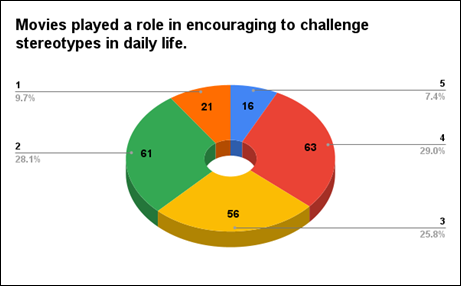
|
Graph 11 Movies Played a Role in Encouraging to Challenge Stereotypes in Daily Life |
The data reflects audience responses on the role of movies
in challenging stereotypes. With 63 viewers rating 4 and 56 rating 3, a
significant portion acknowledges the positive influence of films. However, 61
and 21 viewers rating 2 and 1 respectively suggest some skepticism.
These mixed results indicate that while many recognize Hindi films as a
catalyst for rethinking societal norms, a considerable number remain
unconvinced. This suggests a nuanced impact, highlighting the need for targeted
and conscious efforts in Hindi cinema to more effectively address and motivate
actions against stereotypes in daily life.
12) Do you actively
engage in discussions or social media conversations about movies and their
impact on societal stereotypes? (1 is for the least and 5 is for the
maximum)
Table 9
|
Table 9 Do you Actively Engage in Discussions or Social Media Conversations about Movies and Their Impact on Societal Stereotypes? |
|
|
Discussions
or social media conversations about movies and their impact on societal
stereotypes |
Respondent |
|
5 |
19 |
|
4 |
58 |
|
3 |
43 |
|
2 |
64 |
|
1 |
33 |
|
Total |
217 |
Graph 12
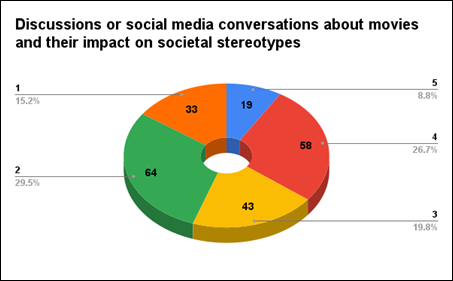
|
Graph 12 Discussions or Social Media Conversations about Movies and their Impact on Societal Stereotypes |
The data indicates varied engagement levels in discussions or social media conversations about movies and their impact on societal stereotypes, with significant interest but mixed opinions. While 19 respondents found such discussions highly relevant (5), and 58 found them fairly significant (4), a substantial number, 64 and 33 respectively, rated their importance as minimal (2) or negligible (1). This suggests a moderate but polarized interest in how Hindi films influence societal stereotypes. The responses highlight a need to delve deeper into the frequency and genre preferences of Hindi film viewers, assess the specific impacts on stereotype perceptions, and evaluate films' roles in motivating anti-stereotype actions.
13) Have you ever
been motivated by movies to educate others about the harmful effects of
stereotypes and biases? (1 is for the least and 5 is for the maximum)
Table 10
|
Table 10 Have you Ever Been Motivated by Movies to Educate Others About the Harmful Effects of Stereotypes and Biases? |
|
|
Movies motivated to educate others about the harmful
effects of stereotypes and biases |
Respondent |
|
5 |
24 |
|
4 |
79 |
|
3 |
47 |
|
2 |
45 |
|
1 |
22 |
|
Total |
217 |
Graph 13
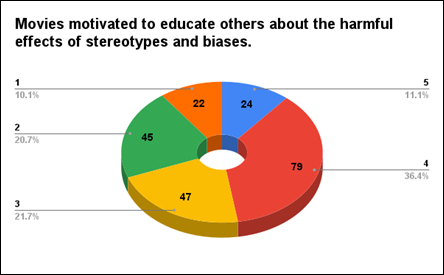
|
Graph 13 Movies Motivated to Educate Others about the Harmful Effects of Stereotypes and Biases |
The data with 217 total respondents reveals varied reception to Hindi films addressing stereotypes. A significant proportion, 79 respondents, rated these movies a 4, indicating a positive reception towards the films' educational impact on stereotypes and biases. However, the mixed responses (47 rating 3, 45 rating 2, and 22 rating 1) suggest a spectrum of perceptions regarding their effectiveness. This highlights the genre's potential in shaping societal views and motivating actions against stereotypes, although the varied frequency suggests room for more impactful storytelling to universally resonate with audiences.
14) Have movies
empowered you to stand up against stereotypes and biases in your personal and
social interactions? (1 is for the least and 5 is for the maximum)
Table 11
|
Table 11 Have Movies Empowered you to Stand up Against Stereotypes and Biases in your Personal and Social Interactions? |
|
|
Movies
empowered to stand up against stereotypes and biases in personal and social
interactions |
Respondent |
|
5 |
25 |
|
4 |
74 |
|
3 |
52 |
|
2 |
48 |
|
1 |
18 |
|
Total |
217 |
The data reflects respondents' views on Hindi films
empowering individuals to confront stereotypes and biases. Among 217
participants, the majority (74) rated this empowerment at level 4, indicating a
strong influence. Ratings 3 and 2 followed with 52 and 48 responses,
respectively, suggesting moderate impact. A smaller segment rated it highest
(5) with 25 responses, and lowest (1) with 18, showing varied perceptions. This
distribution highlights Hindi films' significant role in shaping societal
attitudes, with notable success in motivating actions against stereotypes,
reflecting their influence across different frequency and genre preferences of
viewers.
Graph 14
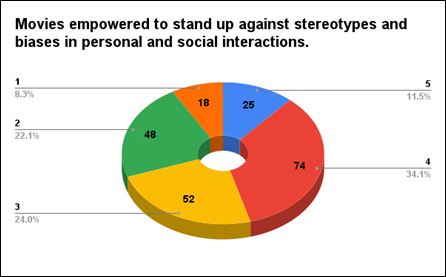
|
Graph 14 Movies Empowered to Stand up Against Stereotypes and Biases in Personal and Social Interactions |
7. Conclusion
This study aimed to assess the relationship between exposure to mainstream commercial Hindi cinema and endorsement of common societal stereotypes among adults in the Delhi NCR region. Quantitative survey data was collected from 217participants aged 18-34 above years regarding their Hindi movie viewership patterns. Results revealed that adults who frequently watched popular Hindi films exhibited greater endorsement of progressive societal approach and have better understanding of gender roles. They also held more biased perceptions aligned with cinematic stereotypes about marginalized castes and classes being suited only for menial roles. Character tropes of elite communities being cultured and intellectual were also strongly endorsed by regular Hindi movie watchers.
Additionally, those highly exposed to formulaic storytelling and stock characters in Hindi films were more likely to hold prejudicial and discriminatory attitudes towards communities portrayed as villains or undesirable elements in mainstream plots. Education and location of residence emerged as moderators, with small town dwellers and lesser educated participants exhibiting higher stereotype endorsement compared to urban residents with college education. Overall, the findings offer empirical evidence for cultivation and social cognitive explanations of media's role in shaping societal perceptions and prejudices.
Overall, the dominance and popularity of escapist Hindi film content relying on reductionist stereotypes continues to perpetuate regressive mindsets and mentalities detrimental to India's growth and development goals. There is an urgent need for more progressive, stereotype-challenging storytelling from the influential Hindi film industry that promotes equality, diversity and inclusion in society. Media literacy initiatives to develop critical thinking among audiences can also protect against harmful media effects. But systemic shifts in filmmaking practices and ideologies are required for transformative social change. The Hindi film industry must recognize its massive responsibility in shaping the nation's conscience and consciousness.
CONFLICT OF INTERESTS
None.
ACKNOWLEDGMENTS
None.
REFERENCES
Ashmore, R. D., & Del Boca, F. K. (1981). Conceptual Approaches to Stereotypes and Stereotyping. Cognitive Processes in Stereotyping and Intergroup Behavior, 1, 35.
Bandura, A. (2001). Social Cognitive Theory of Mass Communication. Media Psychology, 3(3), 265–299. https://doi.org/10.1207/S1532785XMEP0303_03
Baran, S. J., & Davis, D. K. (2009). Mass Communication Theory: Foundations, Ferment, and Future (6th Ed.). Wadsworth Cengage Learning.
Behm-Morawitz, E., & Ortiz, M. (2013). Race, Ethnicity, and the Media. In K. E. Dill
(Ed.), The Oxford Handbook of Media Psychology.
Oxford University Press,
252-266.
Bharucha, R. (2014). Indian Cinema. Sydney University Press.
Chopra, A. (2011). Celebrity, Consumption and Development in Post-Liberalized India. Media International Australia, Incorporating Culture & Policy, 140(1), 76–85. https://doi.org/10.1177/1329878X1114000110
Crocker, J., & Lutsky, N. (1986). Stigma and the Dynamics of Social Cognition. Social Cognition and Clinical Psychology: A Synthesis, 95-121. https://doi.org/10.1007/978-1-4684-7568-5_6
Desai, J. (2004). Planet Bollywood: Indian Cinema Abroad. In R. Dwyer & C. Pinney (Eds.), Pleasure and the Nation. Oxford University Press, 198-224.
Desai, J., & Basuroy, S. (2005). Interactive Influence of Genre Familiarity, Star Power, and Critics' Reviews in the Cultural Goods Industry: The Case of Motion Pictures. Psychology & Marketing, 22(3), 203–223. https://doi.org/10.1002/mar.20055
Dwyer, R. (2014). Bollywood's India: Hindi Cinema as a Guide to Modern India. Reaktion Books.
Ganti, T. (2004). Bollywood: A Guidebook to Popular Hindi Cinema. Routledge.
Gerbner, G., Gross, L., Morgan, M., Signorielli, N., & Shanahan, J. (2002). Growing up with Television: Cultivation Processes. Media Effects: Advances in Theory and Research, 2, 43-67.
Gokulsing, K. M. (2004). Soft-Soaping India: The World of Indian Televised Soap Operas. Trentham Books.
Gorham, B. W. (1999). Stereotypes in the Media: So What? Howard Journal of Communication, 10(4), 229-247. https://doi.org/10.1080/106461799246778
Hilton, J. L., & Von Hippel, W. (1996). Stereotypes. Annual Review of Psychology, 47, 237-271.
Holbert, R. L., Shah, D. V., & Kwak, N. (2004). Fear, Authority, and Justice: Crime-Related TV Viewing and Endorsements of Capital Punishment and Gun Ownership. Journalism & Mass Communication Quarterly, 81(2), 343-363. https://doi.org/10.1177/107769900408100205
Igartua, J.-J., & Barrios, I. (2012). Changing Real-World Beliefs with Controversial Movies: Processes and Mechanisms of Narrative Persuasion. Journal of Communication, 62(3), 514–531. https://doi.org/10.1111/j.1460-2466.2012.01640.x
Karan, K. (2008). Observations on Change and Changelessness in Indian Cinema. India International Centre Quarterly, 34(4), 25-35.
Kaur, R. (2002). Viewing the West through Bollywood: A Celluloid Occident in the Making. Contemporary South Asia, 11(2), 199-209. https://doi.org/10.1080/0958493022000017273
Khan, S., Sultana, N., & Wahid, S. S. (2016). Gender Stereotypes in Hindi Cinema: A Content Analysis Study. Journal of Humanities and Social Science, 21(9), 38-44. https://doi.org/10.9790/0837-2109053844
Mazzarella, W. (2003). Shoveling Smoke: Advertising and Globalization in Contemporary India. Duke University Press.
Punathambekar, A. (2013). From Bombay to Bollywood: The Making of a Global Media Industry. NYU Press.
Ramasubramanian, S. (2011). The Impact of Stereotypical Versus Counterstereotypical Media Exemplars on Racial Attitudes, Causal Attributions, and Support for Affirmative Action. Communication Research, 38(4), 497–516. https://doi.org/10.1177/0093650210384854
Ramasubramanian, S. (2015). Using Celebrity News Stories to Effectively Reduce Racial/Ethnic Prejudice. Journal of Social Issues, 71(1), 123–138. https://doi.org/10.1111/josi.12100
Rao, S. (2010). I Need an Indian Touch: Glocalization and Bollywood Films. Networking Knowledge, 3(1), 23-34. https://doi.org/10.31165/nk.2010.31.276
Sharma, P. (2018). Gender Construction Through Media Consumption Choices: Impacting Attitudes and Behaviours Towards Love and Marriage. Media Watch, 9(3), 414-426. http://dx.doi.org/10.15655/mw/2018/v9i3/49592
Shaver, J. H., Sibley, C. G., Osborne, D., & Bulbulia, J. (2017). News Exposure Predicts Anti-Muslim Prejudice. PloS one, 12(3). https://doi.org/10.1371/journal.pone.0174606
Shrum, L. J. (2004). The Cognitive Processes Underlying Cultivation Effects are a Function of Whether the Judgments are On-Line or Memory-Based. Communications, 29(3), 327–344. https://doi.org/10.1515/comm.2004.021
Shrum, L. J., & Lee, J. (2012). The Stories TV Tells: How Fictional TV Narratives Shape Normative Perceptions and Personal Values. In L. J. Shrum (Ed.), The Psychology of Entertainment Media: Blurring the Lines Between Entertainment and Persuasion. Routledge. (2nd Ed), 147-167.
Virdi, J. (2003). The Cinematic Imagination: Indian Popular Films as Social History. Rutgers University Press.
|
|
 This work is licensed under a: Creative Commons Attribution 4.0 International License
This work is licensed under a: Creative Commons Attribution 4.0 International License
© ShodhKosh 2024. All Rights Reserved.

